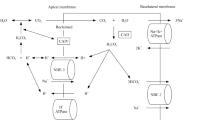Abstract
Objective: To study the etiological profile and patterns of clinical presentation of nephrocalcinosis. Methods: In this observational study, patients 18 years or younger, referred to the pediatric nephrology clinic with nephrocalcinosis were evaluated for etiology. Symptoms/signs at presentation, estimated glomerular filtration rate (eGFR) at presentation and follow-up, and growth parameters were recorded. Results: The etiology of nephrocalcinosis (n=54) included distal renal tubular acidosis (n=18; 33.3%), primary hyperoxaluria (n=9; 16.7%), Bartter syndrome (n=7; 13%), Dent disease (n=4; 7.4%), cystinosis, familial hypomagnesemia with hypercalciuria and idiopathic hypercalcemia of infancy (2 each). Idiopathic nephrocalcinosis was seen in 5 (9.3%) children. Clinical features included failure to thrive (53.7%), polyuria (44.4%), bony deformities (31.5%) and hypokalemic paralysis (11.1%). At a median (IQR) follow-up of 24 (8, 56) months, the mean (SD) eGFR had improved from 59 (25.5) to 77 (31.48) mL/min/1.73m2 (P<0.01). Consanguinity was present in 50% (27/54). Genetic analysis in 5 primary hyperoxaluria cases confirmed AGXT mutations in 4; and GRHPR mutation in 1 child. Conclusion: Distal RTA, primary hyperoxaluria and Bartter syndrome were the common etiologies of nephrocalcinosis in our patient population.
Similar content being viewed by others
References
Ronnefarth G, Misselwitz J. Nephrocalcinosis in children: A retrospective survey. Pediatr Nephrol. 2000;14:1016–21.
Lin MT, Tsau YK, Tsai WY, Tsai WS, Lu FL, Hsiao PH, et al. Nephrocalcinosis in childhood. Acta Paediatr Taiwanica. 1999; 40:27–30.
Manz F, Jaschke W, van Kaick G, Waldherr R, Willich E. Nephrocalcinosis in radiographs, computed tomography, sonography and histology. Pediatr Radiol. 1980;9:19–26.
Doðan CS, Uslu-Gökçeoðlu A, Comak E, Alimoðlu E, Koyun M, Akman S. Renal function and linear growth of children with nephrocalcinosis: A retrospective singlecenter study. Turk J Pediatr. 2013; 55:58–62.
Ammenti A, Pelizzoni A, Cecconi M, Molinari PP, Montini G. Nephrocalcinosis in children: a retrospective multi-centre study. Acta Paediatr. 2009;98:1628–31.
Mantan M, Bagga A, Virdi VS, Menon S, Hari P. Etiology of nephrocalcinosis in northern Indian children. Pediatr Nephrol. 2007;22:829–33.
Schwartz GJ, Work DF. Measurement and estimation of GFR in children and adolescents. Clin J Am Soc Nephrol. 2009;4:1832–43.
Habbig S, Beck BB, Hoppe B. Nephrocalcinosis and urolithiasis in children. Kidney Int. 2011;80:1278–91.
Cameron MA, Sakhaee K, Moe OW. Nephrolithiasis in children. Pediatr Nephrol. 2005; 20:1587–92.
Bhardwaj S, Thergaonkar R, Sinha A, Hari P, Hi C, Bagga A. Phenotype of Dent disease in a cohort of Indian children. Indian Pediatr. 2016;53:977–82.
Al-Bderat JT, Mardinie RI, Salaita GM, Al-Bderat AT, Farrah MK. Nephrocalcinosis among children at King Hussein medical center: Causes and outcome. Saudi J Kidney Dis Transplant. 2017;28:1064–8.
Eggert P, Müller D, Schröter T. Nephrocalcinosis in three siblings with idiopathic hypercalciuria. Pediatr Nephrol. 1998;12:144–6.
Moxey-Mims MM, Stapleton FB. Hypercalciuria and nephrocalcinosis in children. Curr Opin Pediatr. 1993;5:186–90.
Lieske JC, Monico CG, Holmes WS, Bergstralh EJ, Slezak JM, Rohlinger AL, et al. International registry for primary hyperoxaluria. Am J Nephrol. 2005;25:290–6.
van Woerden CS, Groothoff JW, Wanders RJA, Davin J-C, Wijburg FA. Primary hyperoxaluria type 1 in The Netherlands: prevalence and outcome. Nephrol Dial Transplant. 2003;18:273–9.
Funding
Funding: Supported, in part, by institutional and departmental funds.
Author information
Authors and Affiliations
Contributions
Contributors: KR, SK, PS: management of the patients; KR: collected the data, reviewed the literature and drafted the first version of the manuscript; SK: conceptualized the study, collected the data, reviewed the literature, revised the manuscript and critically reviewed the manuscript. All authors contributed to drafting of the manuscript and approved the final version of the manuscript; SK: shall act as guarantor of the paper.
Corresponding author
Rights and permissions
About this article
Cite this article
Ramya, K., Krishnamurthy, S. & Sivamurukan, P. Etiological Profile of Nephrocalcinosis in Children from Southern India. Indian Pediatr 57, 415–419 (2020). https://doi.org/10.1007/s13312-020-1814-x
Received:
Revised:
Accepted:
Published:
Issue Date:
DOI: https://doi.org/10.1007/s13312-020-1814-x




